Hiking trails in the United States offer an abundance of edible berries that are great for raw snacking. They add fiber, vitamin C, and antioxidants to your trail diet. Blueberries, blackberries, huckleberries, mulberries, raspberries, and strawberries, are just a few examples of the delicious and nutritious berries you may encounter.
If you’d like to try foraging wild berries, here’s what you need to know about identifying them, when they typically ripen, and where you’ll most likely find them.
Blackberries
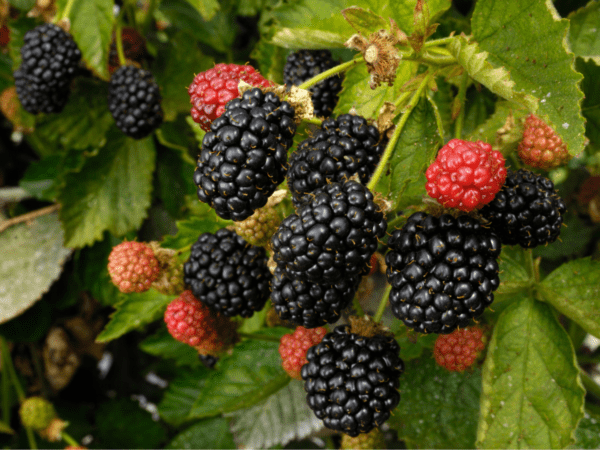
Blackberries are easy to spot because the fruit is aggregated, meaning each berry contains a cluster of tiny round berries. Blackberries are a deep purple to black when fully ripe and taste juicy and sweet.
How to Identify: Wild blackberry plants grow on thorny bushes with toothy oval-shaped compound leaves with three leaflets. The entire fruit comes off as one piece when picked.
Harvest Season: Wild blackberries start ripening in the middle of the summer to as late as September. Blackberries range from red while ripening and deep purple to black when fully ripe. Pick black-colored berries which are fully ripened and taste the sweetest. Red blackberries will taste bitter and tart.
Where they are found: Throughout the U.S., most commonly in the western coastal states of California, Oregon, and Washington.
Blackberry, raspberry, dewberry, boysenberry — what’s the difference? Blackberries have many lookalikes, but all of those lookalikes are safe to eat. Every region of the U.S. has blackberry-like fruit growing in the wild, most of which are native to the Pacific Northwest. Most people confuse black raspberries with blackberries, but spotting the difference is easy. Blackberry fruit has a solid white core with oblong-shaped berries, while black raspberries are smaller and more rounded with a cup-shaped, hollow center.
Raspberries

Raspberries are aggregate fruits growing in clusters, with small, red berries similar in appearance to blackberries. While most raspberries are red, less common varieties are black. Wild raspberries have a sweet, slightly tart taste.
How to Identify: Wild raspberries grow on short and thorny shrubs. The leaves are toothy, with three to five leaflets. The flowers are white with a yellow center. All raspberries are hollow because the core gets left behind when picked from the stem.
Harvest Season: Wild raspberries typically ripen in late summer to early fall. Pick fully ripened berries that come off the stem easily. Ripe raspberries are brightly colored, whether they are red or another variety. You can make a herbal tea with the leaves.
Where they are found: Found throughout the U.S., most commonly in New York, Michigan, and Oregon.
Common Identity Mistake: The non-toxic thimbleberry plant is sometimes confused with raspberries. You can spot the difference by the stem. Raspberry plants have thorns, while thimbleberries do not. Thimbleberries also look more like a thimble, having a broader and flatter shape than a raspberry.
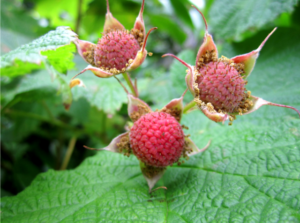
Blueberries
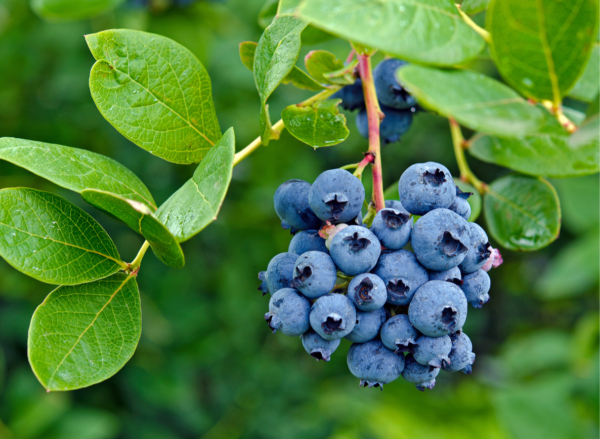
Blueberries are one of the most common berries in the United States, and the round and blue-colored berries are easily identifiable. In the wild, the berries tend to be smaller than store-bought blueberries and more tart.
How to Identify: Wild blueberries grow in low shrubs and bushes and are found in forests, meadows, and other areas with moist soil. Blueberry bushes have broad, glossy blue-green leaves with thin branches. Flowers are white or light pink. Blueberries contain a 5-pointed papery “crown” on one end of the fruit.
Harvest Season: Wild blueberries typically ripen in mid to late summer. When picking blueberries, look for plump, firm, and fully ripened berries which will taste the sweetest.
Where they are found: Blueberries grow in many U.S. states, most commonly in the Northeast and upper Midwest, including Maine, Michigan, New Jersey, and Minnesota.
Common Identity Mistake: Wild blueberries may be confused with the Virginia Creeper, a vine with rounded purple berries that are toxic and taste extremely bitter. The flavor should stop anyone from eating a second. Huckleberries also look similar to blueberries but are fine to eat.
Huckleberries
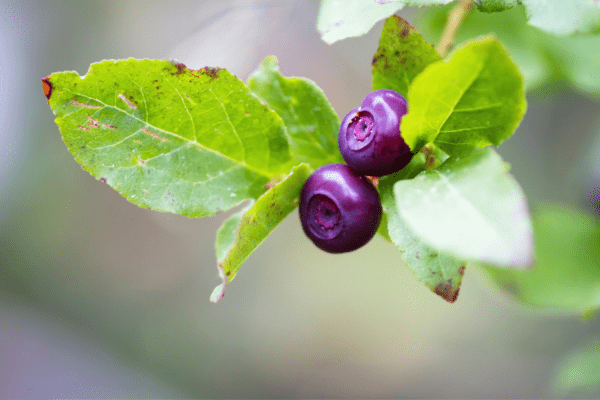
Huckleberries are a lesser-known berry and look very similar to blueberries with a round shape and purple-blue color. The berries are smaller than a wild blueberry and grow in clusters. Huckleberries are prized for their high levels of antioxidants. Huckleberries have a sweet, slightly tart taste.
How to Identify: They typically grow on waist-high bushes in dense thickets with dark green leaves that turn bronze to reddish-purple in Autumn. Flowers are bell-shaped. The round, dark purple-blue berries contain ten hard seeds.
Harvest Season: Wild huckleberries typically ripen in late summer to early fall.
Where they are found: Huckleberries are commonly found growing in Montana, Idaho, Oregon, Washington, and Alaska.
Common Identity Mistake: Huckleberries can be mistaken for blueberries which is not a concern because both are edible. You can identify huckleberries from blueberries by their hard interior seeds.
Mulberries

Mulberries grow in aggregated clusters and look similar to blackberries, although they grow on trees rather than a bush. The sweet, juicy berries are packed with vitamin C. Berries may be purple-black, red, or pinkish.
How to Identify: To identify wild mulberries, look for trees with simple toothed leaves that are glossy and slightly oval with three lobes. The flowers are small and white and grow in clusters.
Harvest Season: Wild mulberries usually ripen in late spring to early summer. Unripe berries or sap may be toxic or hallucinogenic.
Where they are found: You’ll most commonly encounter wild mulberries in Texas, Oklahoma, Kansas, and Missouri.
Common Identity Mistake: Mulberries look similar to raspberries or blackberries but are more oblong than round.
Strawberries
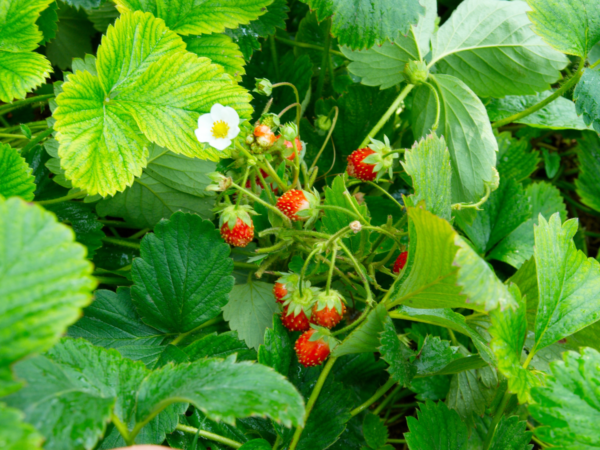
Strawberries have a red color and a sweet taste. This highly favored berry is easily identifiable by the tiny seeds around the shallow pits of the oblong-shaped berry (technically a drupe). Wild strawberries are sweeter, smaller, and less rounded than cultivated strawberries found in stores. Strawberries are a great way to add vitamin C and antioxidants to your trail diet.
How to Identify: Wild strawberries grow close to the ground on small creeping plants with three leaflets that are slightly hairy on the underside. Flowers are white and have five petals.
Harvest Season: The berries ripen in early summer. When picking strawberries, look for fully ripened berries, deep red berries that are firm to the touch. Unripe berries are white to light green.
Where they are found: Most commonly found in the U.S. states of New York, North Carolina, Minnesota, and California.
Common Identity Mistake: Some people mistake wild strawberries for a “wood strawberry” or “false strawberry,” neither poisonous. The easiest way to distinguish the two is from the blossoms. Wild strawberries have white blossoms, whereas mock strawberries have yellow flowers. Wild strawberries can also be identified by how they hang on the vine. Wild strawberries dangle towards the ground while the less flavorful mock version points upwards.
In Summary
While hiking trails in the USA contain an abundance of these common edible berries, there are many more. Finding the less common berries can add to the culinary excitement of your hiking adventures, but we’ll leave that one to the experts.
Consider any potential risks associated with consuming wild berries. For example, some berries may grow near pesticide or chemical runoff, which could be harmful if ingested. Finally, some lookalike berries can be poisonous. You’ll often know when you take the first bite. Some berries should be neither consumed nor touched. For example, the berries of the Poison Ivy plant are toxic if touched or ingested. If in doubt, it’s best to avoid eating them.
One thought on “Identifying Edible Berries on U.S. Hiking Trails”
All poisonous berries in North America taste bad. So taste one, if it is nasty, spit it out and rinse your mouth.